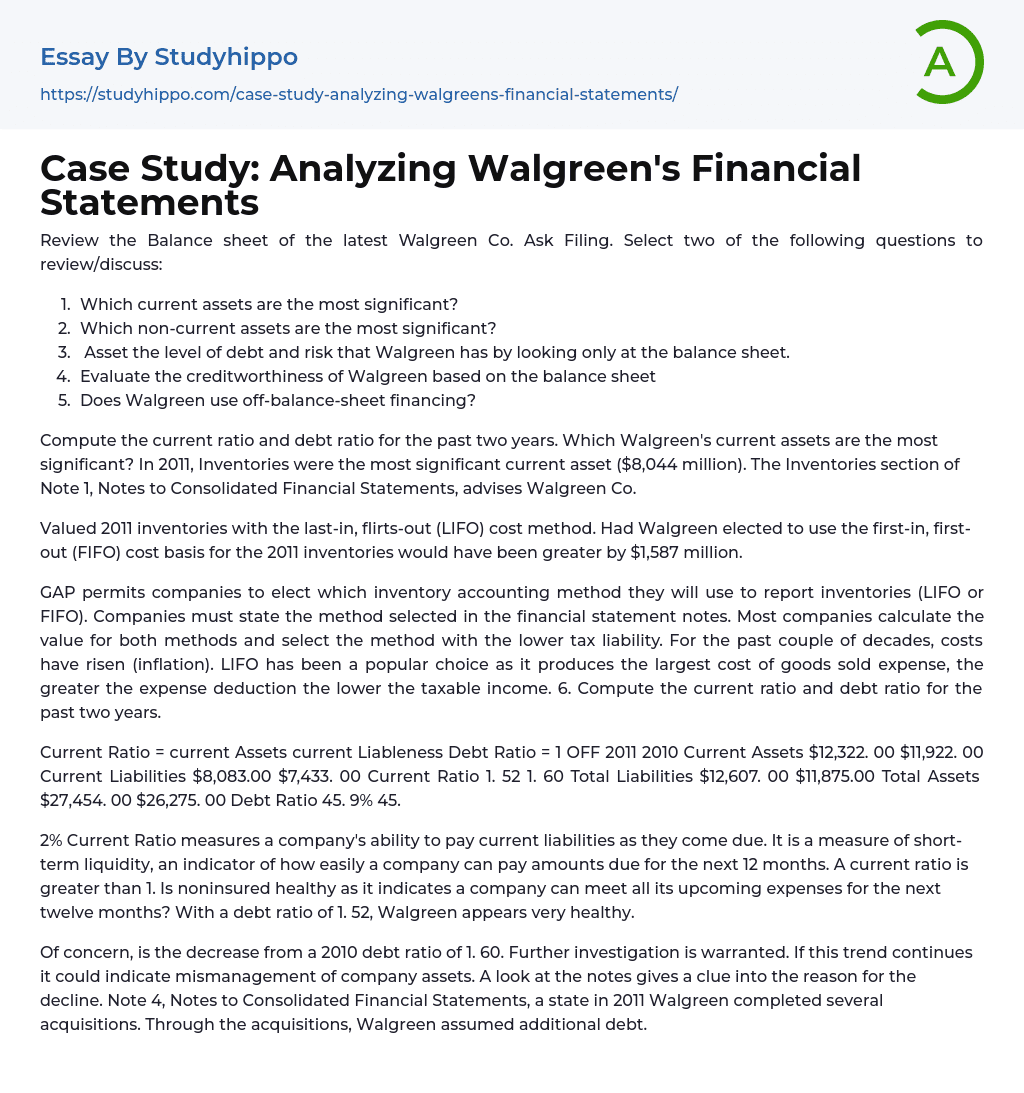

Case Study: Analyzing Walgreen’s Financial Statements Essay Example
Review the Balance sheet of the latest Walgreen Co. Ask Filing. Select two of the following questions to review/discuss:
- Which current assets are the most significant?
- Which non-current assets are the most significant?
- Asset the level of debt and risk that Walgreen has by looking only at the balance sheet.
- Evaluate the creditworthiness of Walgreen based on the balance sheet
- Does Walgreen use off-balance-sheet financing?
Compute the current ratio and debt ratio for the past two years. Which Walgreen's current assets are the most significant? In 2011, Inventories were the most significant current asset ($8,044 million). The Inventories section of Note 1, Notes to Consolidated Financial Statements, advises Walgreen Co.
Valued 2011 inventories with the last-in, flirts-out (LIFO) cost method. Had Walgreen elected to use the first-in, first-out (FIFO) cost basis for the 2011 i
...nventories would have been greater by $1,587 million.
GAP permits companies to elect which inventory accounting method they will use to report inventories (LIFO or FIFO). Companies must state the method selected in the financial statement notes. Most companies calculate the value for both methods and select the method with the lower tax liability. For the past couple of decades, costs have risen (inflation). LIFO has been a popular choice as it produces the largest cost of goods sold expense, the greater the expense deduction the lower the taxable income. 6. Compute the current ratio and debt ratio for the past two years.
- Current Ratio = current Assets
- current Liableness Debt Ratio = 1 OFF 2011 2010
- Current Assets $12,322. 00 $11,922. 00
- Current Liabilities $8,083.00 $7,433. 00
- Current Ratio 1. 52 1. 60
- Total Liabilities $12,607. 00 $11,875.00
- Total Assets $27,454
00 $26,275. 00
Current Ratio measures a company's ability to pay current liabilities as they come due. It is a measure of short-term liquidity, an indicator of how easily a company can pay amounts due for the next 12 months. A current ratio is greater than 1. Is noninsured healthy as it indicates a company can meet all its upcoming expenses for the next twelve months? With a debt ratio of 1. 52, Walgreen appears very healthy.
Of concern, is the decrease from a 2010 debt ratio of 1. 60. Further investigation is warranted. If this trend continues it could indicate mismanagement of company assets. A look at the notes gives a clue into the reason for the decline. Note 4, Notes to Consolidated Financial Statements, a state in 2011 Walgreen completed several acquisitions. Through the acquisitions, Walgreen assumed additional debt.
- Accounts Receivable essays
- Auditor's Report essays
- Balance Sheet essays
- Costs essays
- Financial Audit essays
- International Financial Reporting Standards essays
- Tax essays
- Accountability essays
- Cash essays
- Principal essays
- Management Accounting essays
- Internal Control essays
- Accounting Software essays
- Cash Flow essays
- Accounting essays
- Andrew Carnegie essays
- Automation essays
- Business Cycle essays
- Business Intelligence essays
- Business Model essays
- Business Operations essays
- Business Software essays
- Cooperation essays
- Cooperative essays
- Corporate Social Responsibility essays
- Corporation essays
- Customer Relationship Management essays
- Family Business essays
- Franchising essays
- Harvard Business School essays
- Harvard university essays
- Human Resource Management essays
- Infrastructure essays
- Inventory essays
- Logistics essays
- Management essays
- Manufacturing essays
- Market essays
- Marketing essays
- Multinational Corporation essays
- News Media essays
- Online Shopping essays
- Quality Assurance essays
- Richard Branson essays
- Sales essays
- Selling essays
- Shopping Mall essays
- Small Business essays
- Starting a Business essays
- Stock essays



